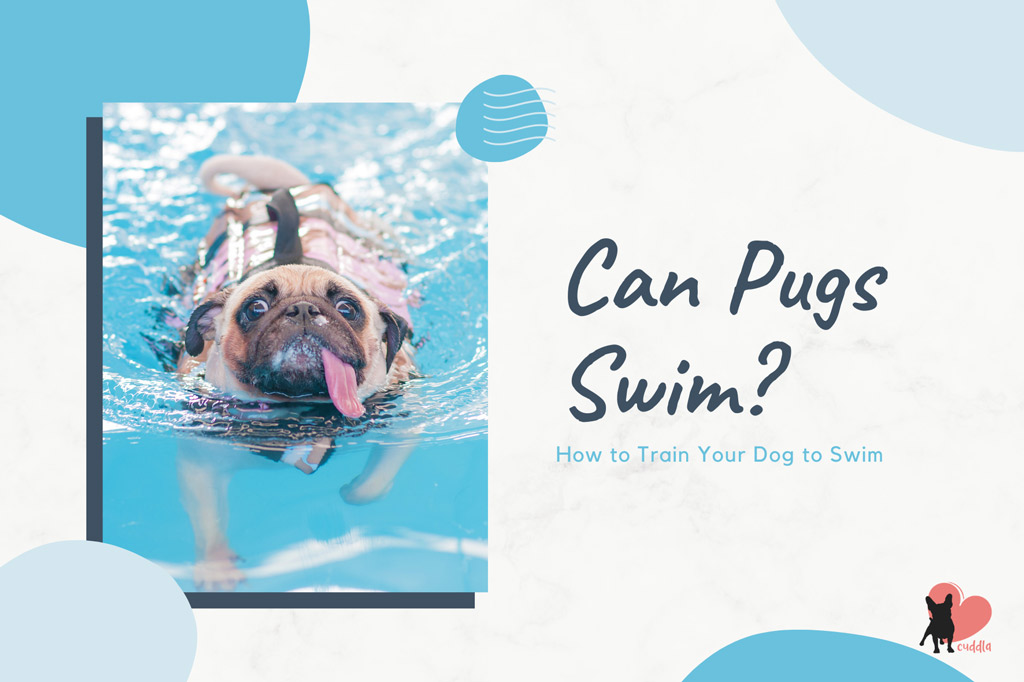
Not all dogs like water and not all dogs know how to swim without being trained. So, can Pugs swim?
Pugs are not natural swimmers, they weren’t bred for swimming. But Pugs can swim if they are taught early on. As a brachycephalic breed, Pugs have a more difficult time breathing while swimming.
Let’s see how to introduce your Pug to water and how to train them to swim!
Can Pugs Swim?
There’s a misconception about all dogs having a natural instinct when it comes to swimming.
Also, Pugs not being able to swim due to being a brachycephalic breed is another misconstruction. Breeds that also belong in this category include French Bulldogs, English Bulldogs, Boston Terriers, Boxers, and more.
Brachycephalic dogs have the reputation of being bad swimmers. But, how much of that is true?
Pugs aren’t natural swimmers unlike Spaniels, Retrievers, and Poodles, which love water and are great swimmers.
However, Pugs can swim if they are introduced to water from a young age and trained how to swim. Also, they will instinctively dog paddle when put in water.
Continue reading to know how to train your dog to swim!
Why Pugs Are Not Good Swimmers?
Pugs are not considered good or natural swimmers.
But, why do dogs like Pugs struggle to swim while other dogs excel?
There are three breed characteristics that limit the distance and the time that Pugs can swim.
#1 – Short Snout
First, due to their heavier heads and short snouts, Pugs have a more difficult time keeping their head afloat and breathing while swimming.
Their physical structure is not ideal for swimming. This is a brachycephalic breed trait, i.e., dogs with this physical characteristic are called brachycephalic dogs.
According to Rowena Packer DVM, the Pug’s facial structure restricts airflow and makes it much more difficult to breathe.
That’s why Pugs cannot and shouldn’t be allowed to swim for great distances or a long time.
For this same reason, they should always use a life vest in water. Follow the Pug Swimming Safety Tips section further down for more info!
#2 – No Webbed Feet
Secondly, Pugs don’t have “webbed feet” (skin between their toes that covers the entire opening). Their webbing only goes about 1/2 to 3/4 between the toes and it’s not as elastic.
Dogs with webbed paws such as Labradors are able to swim much stronger and longer than non-webbed feet dogs.
#3 – Short Legs
Apart from having a heavier head and a short snout, Pugs also have short legs and a long body. All these physical traits make their body not ideal for swimming.
Although, having short legs and an elongated body doesn’t equal to being a bad swimmer.
Corgis, for instance, also have short legs and a long body. The difference is that their legs are very strong. This is a herding type of dog, bred to herd cattle and other livestock.
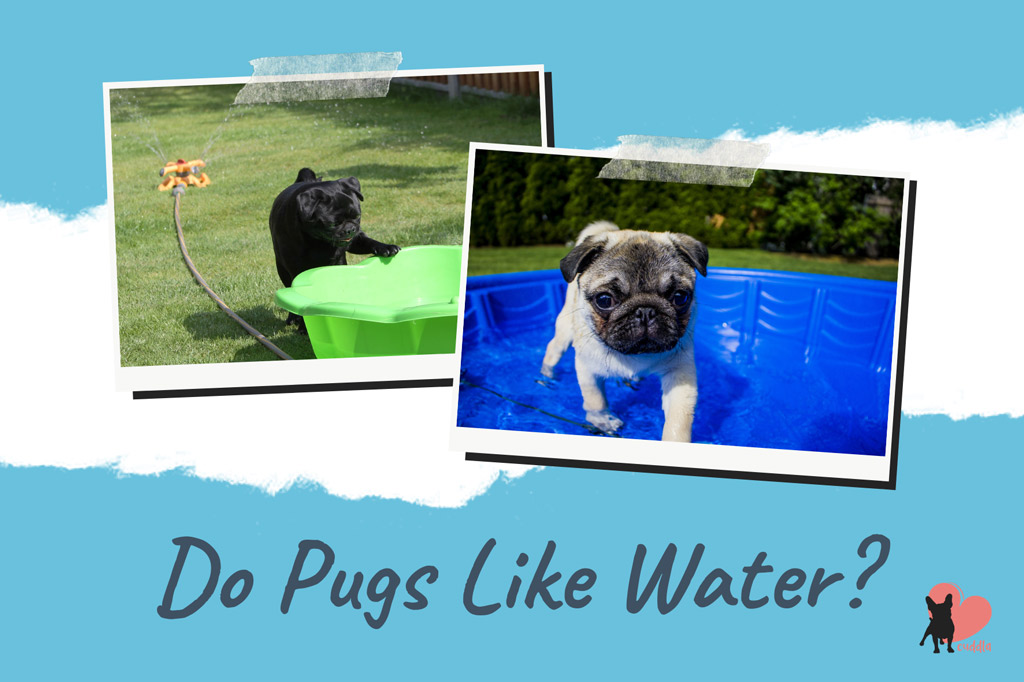
Do Pugs Like Water?
Pugs are more likely to love water if you introduce them to it when they are young.
But, how can you tell if your Pug likes water?
According to Rover, Pugs make the list of dogs that don’t love water along with other toy dogs (you’ll find the full list further down).
It depends on your dog’s previous experiences with water and personality. Every dog is different!
Some pugs will hate water, and will fight you tooth and nail before getting in the water!
But… If you notice your Pug getting excited around water and being eager to approach it, the chances are she likes it!
Continue to introduce your Pug to different water experiences – this is your chance to give the swimming lesson a try!
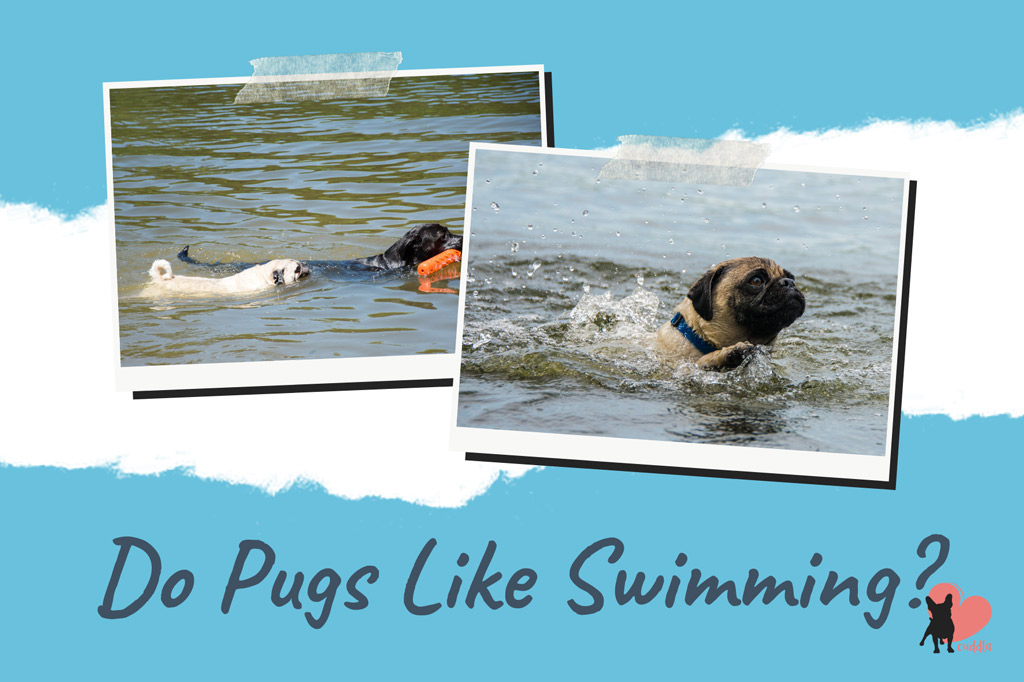
Do Pugs Like Swimming?
Pugs likelihood to swim will depend on their personality and previous experiences with water.
Once you know if your Pug likes water, you can progress to swimming lessons.
Wondering how Pugs compare to other dogs? Here’s a list of dogs that love to swim and those that don’t.
Dogs Who Love to Swim
- Retrievers: Golden Retriever, Labrador Retriever…
- Spaniels: American Water Spaniel, Boykin Spaniel…
- Newfoundland.
- Standard Poodle.
- Water Dogs: Barbet, Spanish Water Dog…
- English Setter.
- Otterhound.
- Schipperkes.
These are all natural-born swimmers (source).
Dogs That Don’t Like Water
- Chihuahua.
- Yorkshire Terrier.
- Shih Tzu.
- Maltese.
- Pomeranian.
- Greyhound.
- Bichon Frise.
- Dachshund.
These dogs (mostly toy breeds) are not too fond of water (source). No surprise there since they are bred as companion dogs, not working dogs!
Read also: What Do Pugs Like to Play With? 10 Fun Pug Activities.
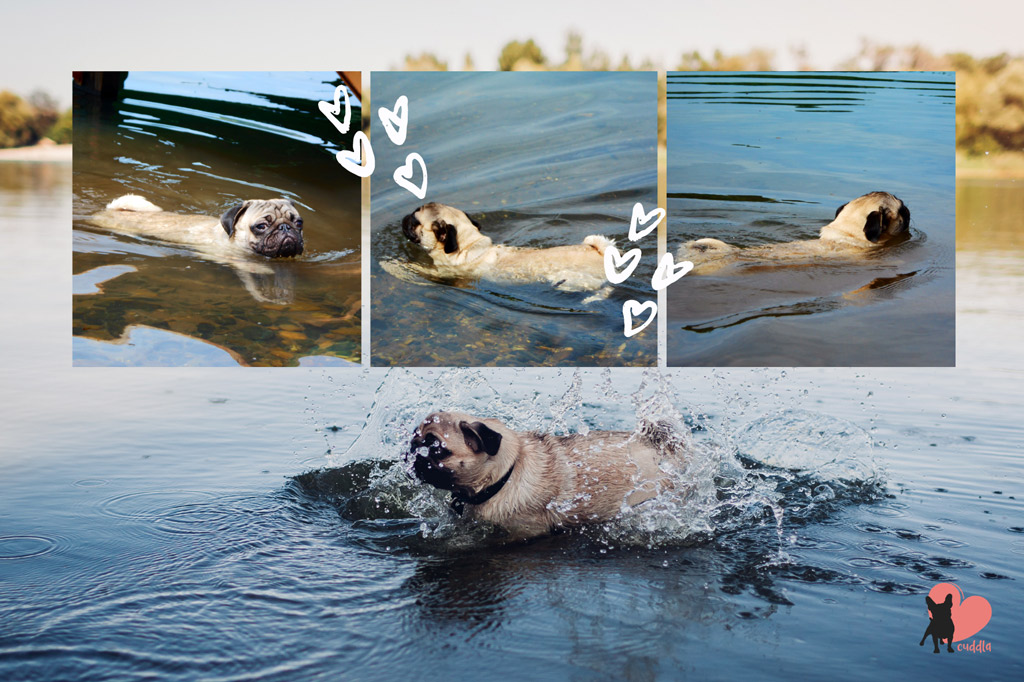
How to Train Your Pug to Swim
Here’s the fun part: teaching your Pug how to swim!
#1 – Introduce Your Pug To Water Slowly
The earlier you introduce your dog to water the easier it will be for her to learn. However, you should wait until your Pug is 4 to 6 months old before teaching her to swim.
This is to ensure that your Pug is strong enough to be able to swim. Also, it will establish that your dog is able to withstand temperature changes.
You can start by taking a garden hose and sprinkling water near her and see if she approaches.
Encouraging your pooch to play in a foldable pool in the garden is the next step. Just keep the water high enough to cover her paws.
If possible, try to keep the water at room temperature. You want to avoid your dog’s first experience with a water surface being a shocking one.
Think of gradually introducing water surfaces like lakes, beaches or a swimming pool as part of your pup’s socialization.
By introducing I mean letting your Pug sniff around and maybe dip one paw into the water. The goal is to let her find out if she likes water! 🙂
One of the worst things you can do is to throw your pooch into a pool and expect them to stay afloat. If you want your Pug to enjoy the experience, you need to acclimate her slowly to the water.
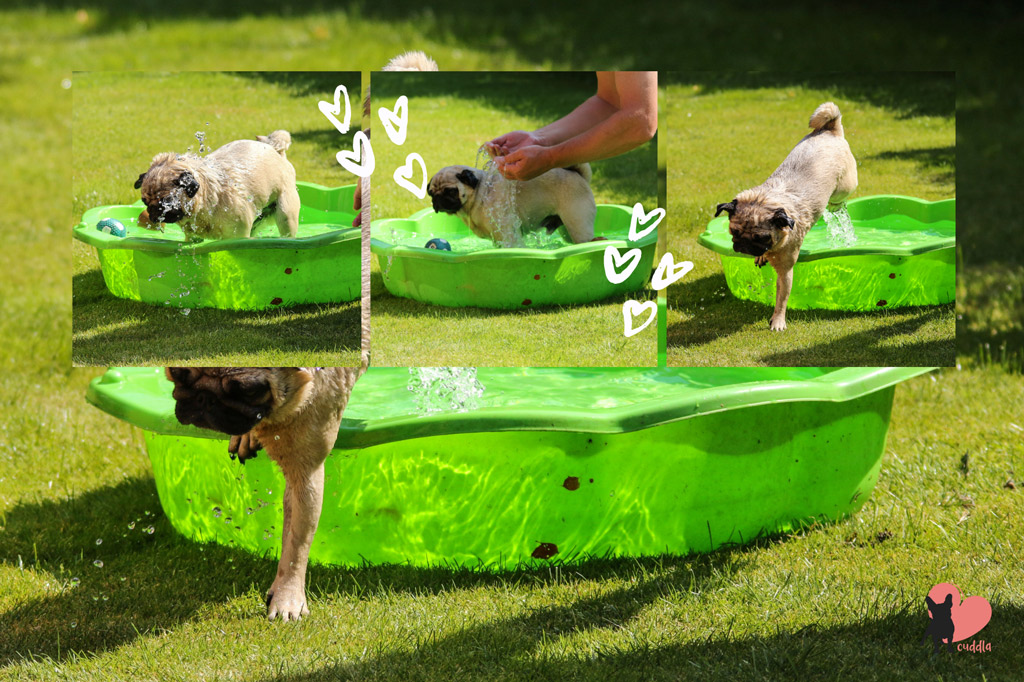
#2 – Start With Swimming Lessons
Once your Pug is happy in the water…
- Fill your bathtub or small foldable pool with water.
- Gently place your dog into the water. You can start with the feet first to get her used to the water (the water level being low). Use encouraging voice tones and treats to reward your pooch.
- Continue doing this until your dog is comfortable with a higher level of water, but without being submerged in water. The goal is for her to start to paddle (the “Dog Paddle”).
- Support your dog’s weight until she paddles. Even if she’s wearing a life vest, you can support her midsection and hindquarters in the water until she starts paddling comfortably.
- Once she’s used to water and paddles, you can take her to a bigger swimming pool or lake.
- Use a dog life jacket for safety and show her how to get out of water too. If you are in a pool, show her where the steps are.
- Carefully guide your dog into the water. At first, she will more than likely swim back to the edge as soon as possible. However, after several attempts, your Pug may start to stay in the water for longer periods of time.
- Let your pooch explore the area at her own pace and encourage her with a game. To make it a better experience for your Pug try floating toys that your dog may wish to swim to.
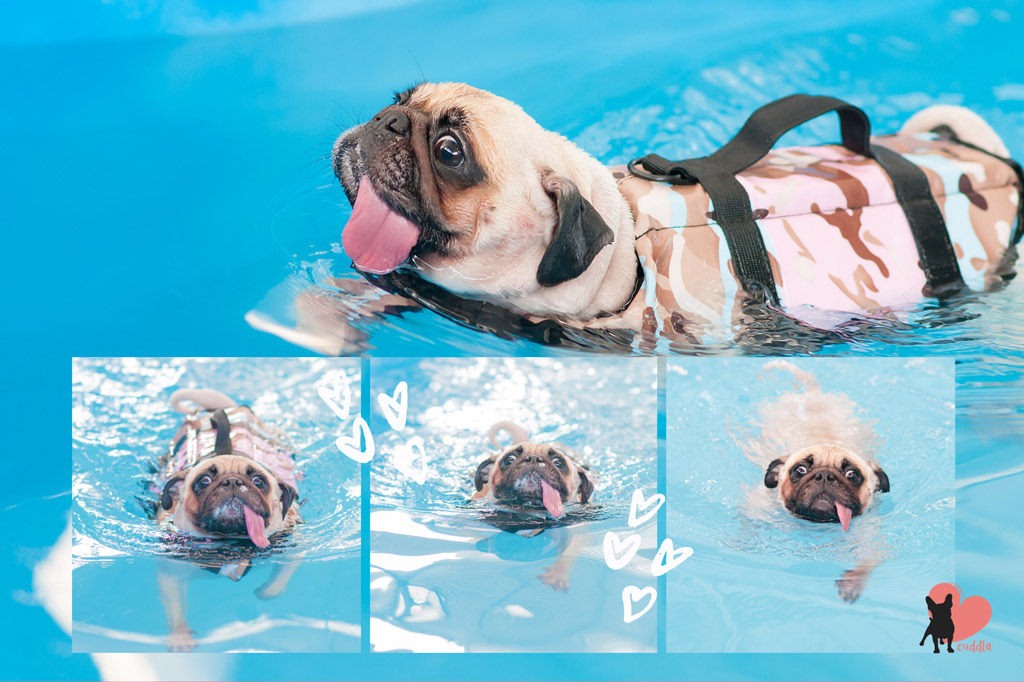
Pug Swimming Safety Tips
Regardless of how great of a swimmer your Pug is…
#1 – Never Leave Your Dog Unsupervised
Never leave your Pug alone in or around water. Swimming should always be a supervised activity.
Basically, do the same that you would do with kids. You either join your dog for a swim or be as close as possible. i.e. you are her lifeguard, so stay on duty ;).
#2 – Always Put a Life Jacket on Your Dog
Since Pugs are not natural swimmers, they are at more risk of drowning than other dogs.
Your Pug should be wearing a life jacket when swimming to prevent her from drowning.
Pugs get tired quicker than natural swimmer dogs. So, life jackets are a great safety tool.
Plus, dogs can get themselves in situations where it may be difficult to swim out of (for instance, in a wavy sea). A life jacket will keep your dog afloat until you get to her!
#3 – Watch Out for Signs of Exhaustion
It’s important to watch your Pug closely whenever she’s in or around water.
As I mentioned, Pugs get tired more easily and they can get into unsafe situations.
So, to avoid any accidents, keep a close eye on your pooch. 🙂
Before moving to tip #4 and different water surfaces…
Did you know that Pug surfing is a thing?!
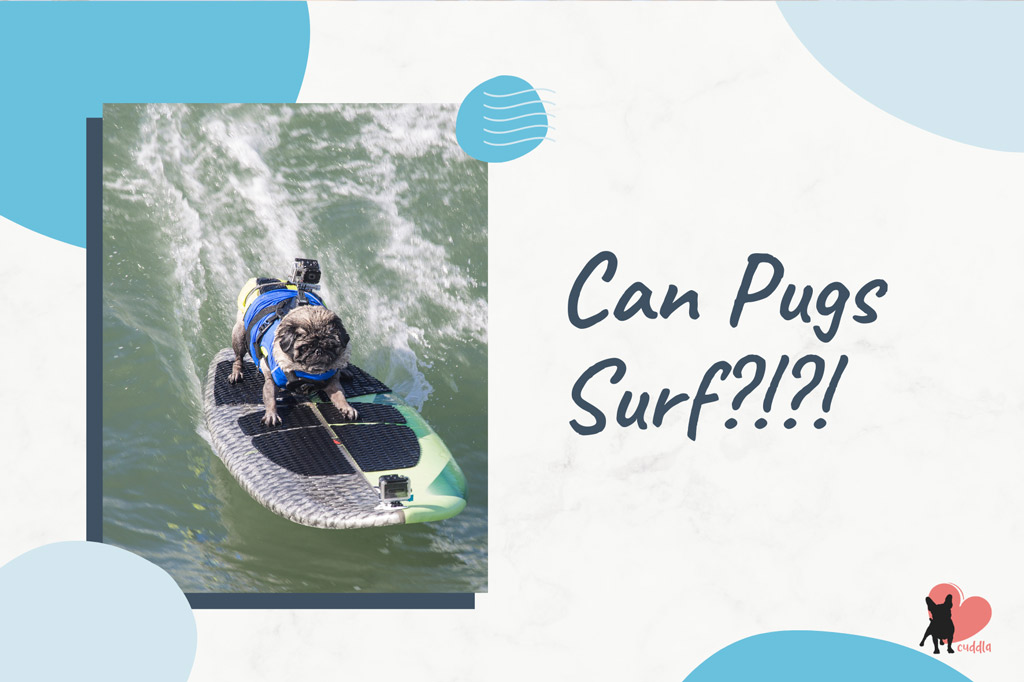
#4 – Be Mindful of the Water Itself
The water itself is something to take into account when swimming.
Swimming Pools
Will pool chlorine hurt my Pug?
Just as pool chemicals can irritate a person’s skin, they will also affect dogs. Plus, Pugs are known for having sensitive eyes and skin.
After a few minutes of being in a pool, take some time to check on your pooch.
If you notice any irritation, such as redness on the skin or bloodshot eyes, remove your Pug from the water and bathe her immediately.
If your Pug seems to be able to tolerate the chlorine, you let her swim for another 5 – 10 minutes.
However, it’s recommendable to choose an alternative to pools that use chlorine.
Lakes, Ponds and Rivers
Make sure the body of water (lake, pond or river) is safe for you before letting your Pug take a dip.
While natural water sources don’t usually have chemicals, there are other potential hazards:
- Blue-green algae: Even a very small exposure to these cyanobacteria (just a mouthful of water with this sort of algae) can be fatal to dogs. It is most common in non-flowing freshwaters such as lakes and ponds. Signs of poisoning include vomiting, diarrhoea, seizures, trouble breathing, etc. Sadly, exposure to toxic blue-green algae is often fatal. Call your vet immediately if you suspect poisoning (source).
- Leptospirosis: It’s a blood infection caused by the bacteria Leptospira. It damages vital organs such as the liver and kidneys. It can be caught from infected water; the disease is carried by the urine of wild animals (source).
Dogs usually don’t get any protection against leptospirosis unless an owner asks for this inoculation specifically.
If where you live poses a risk to your Pug, protect her by vaccinating against leptospirosis.
This is where pet insurance becomes important for ensuring your Pug’s health at all times. My recommendation is Petplan pet insurance, who cover a wide range of veterinary treatments for dogs.
The Sea
A dog-friendly beach can be great swimming spot.
Here’s what to keep an eye on (source):
- Tides: Check that sea conditions are safe before letting your Pug swim.
- The tide times.
- Any warning flags or signs.
- The size of the waves.
- Broken glass or sharp objects: Sadly, you can find trash at the beach and some objects can cut your Pug’s paw pads. Having a first-aid kit at hand is very useful.
- Sand: Swallowing sand can cause stomach problems for your dog. So, be careful when playing with toys since your dog can accidentally swallow sand. Choose rubber toys like a Kong Flyer (soft rubber frisbee) and Chuckit! Ultra Squeaker Ball (squeaky rubber ball) because they pick up less sand than a fuzzy tennis ball.
- Seawater: Drinking salty water can cause diarrhoea and dehydration. Stop your Pug from drinking seawater from rock pools or puddles. Carrying a dog water bottle with fresh water comes in handy.
- Seaweed and other sea life: Keep a close eye on your Pug to prevent her from eating seaweed or getting too close to jellyfish.
Read also: Dog Care during Vacations – Get Ready for Summer – where I share tips to prevent heatstroke and sunburn!
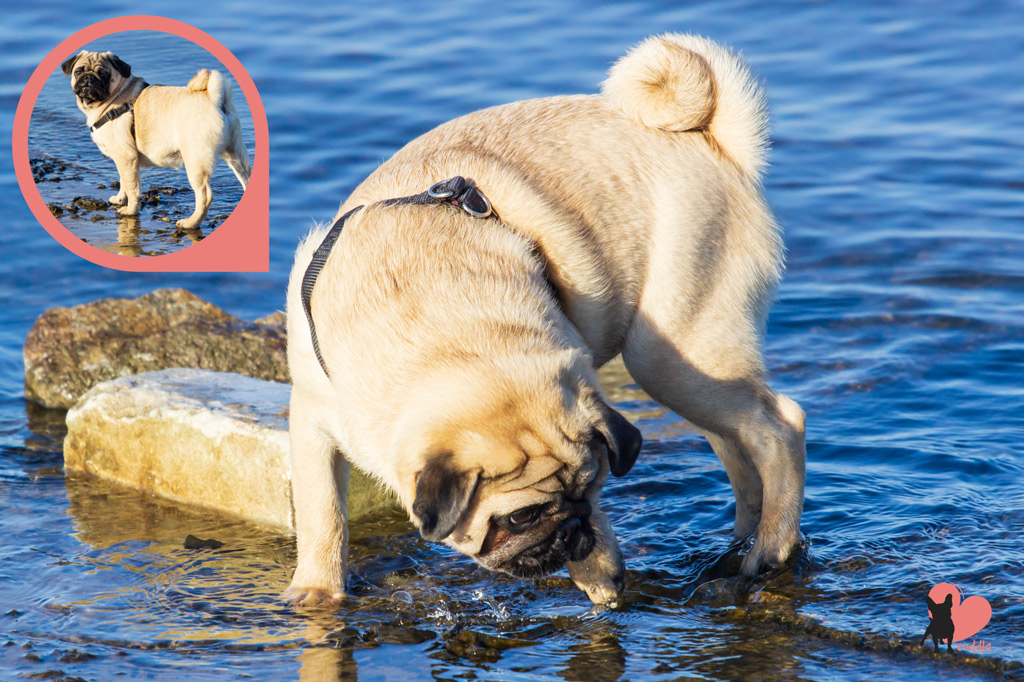
#5 – Thoroughly Dry the Ears and Wrinkles
After swimming, it’s important to rinse your dog off well with fresh water, to get rid off any traces of chlorine, sand and other substances.
Once your Pug is clean, dry her thoroughly. Get those face wrinkles and body rolls completely dry.
Also, pay close attention to your Pug’s ears! These are especially susceptible to infections.
Leftover moisture can cause fungal infections and skin irritation. Ear infection (Otitis externa) can cause inflammation of the ear canal, itchiness, redness, and pain.
To minimize the risk of infection, you can use dog wipes (I always keep these with me) to remove harmful substances in both wrinkles and ear canals, and then pat dry with a towel.
If your Pug gets an ear infection, you will need to take her to the vet. This is why having pet insurance is important (I recommend Petplan), especially if your Pug likes swimming!
Read also: Why Do Pugs Smell? 7 Tips to Stop Bad Odour in Dogs – for how to clean your Pug’s ears and wrinkles.
#6 – If You Have a Pool…
Here’s what you can do to make it safe:
- Get a pool cover: Pool covers are a great way to keep debris out of your pool, but they can be a great way to keep your dog safe.
- Use a fence: You can also consider investing in a self-closing gate kit. Both options are great to keep your pets and kids safe when they are outside in the garden.
Even if your Pug can swim, it’s safer to keep her out of the water when unsupervised.
Accidents can happen at the blink of an eye, so it’s better to be safe than sorry. 🙂

